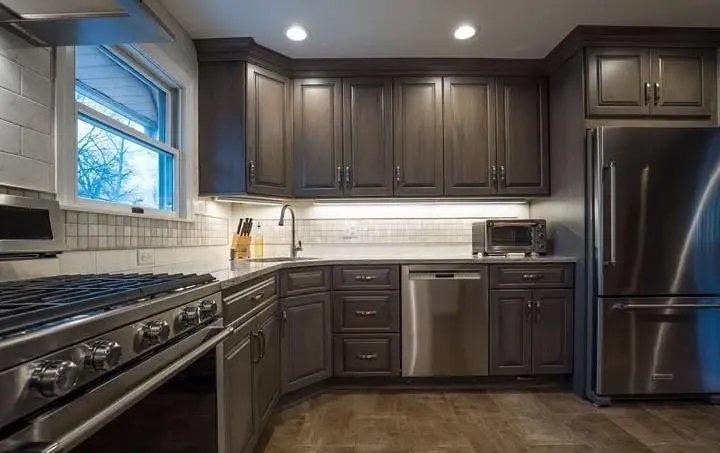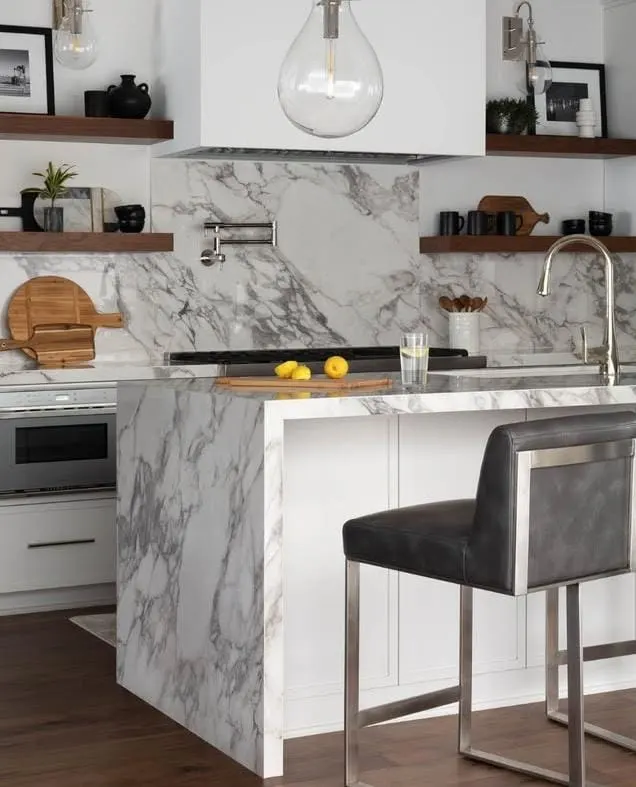15 Two-Tone Kitchen Cabinet Ideas That Bring Perfect Balance to Your Home
The kitchen isn’t just a place where meals are made; it’s where stories begin — early morning coffee moments, family laughter over dinner, and the quiet comfort of late-night snacks. And just like those moments, your kitchen deserves a balance of energy and calm — something that makes you feel good every time you walk in.
Two-tone kitchen cabinets are one of the most effortless ways to bring that sense of harmony. They blend light and dark, warm and cool, modern and classic — all in one frame. Whether you love crisp whites paired with deep navy or earthy woods contrasting with soft cream, two-tone cabinets add instant dimension and depth. In 2025, this trend is everywhere — not just because it’s stylish, but because it feels timeless and personal.
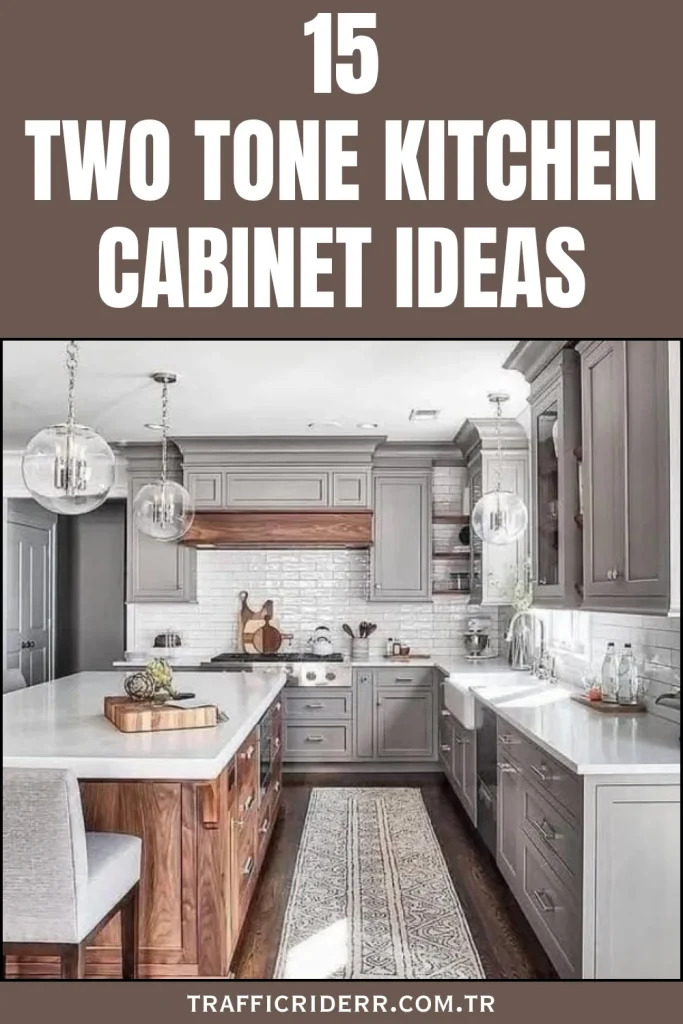
Also read: 15 Black and Grey Bedroom Ideas
Why Two-Tone Cabinets Are More Than a Trend
Two-tone kitchens are for those who crave balance. The mix of colors, materials, and textures helps your kitchen feel grounded yet inspiring. Lighter uppers make the room seem larger, while darker bases add cozy character. It’s a visual conversation between contrast and unity — a design choice that makes your kitchen unique without overwhelming it. When done right, it instantly boosts both elegance and practicality.
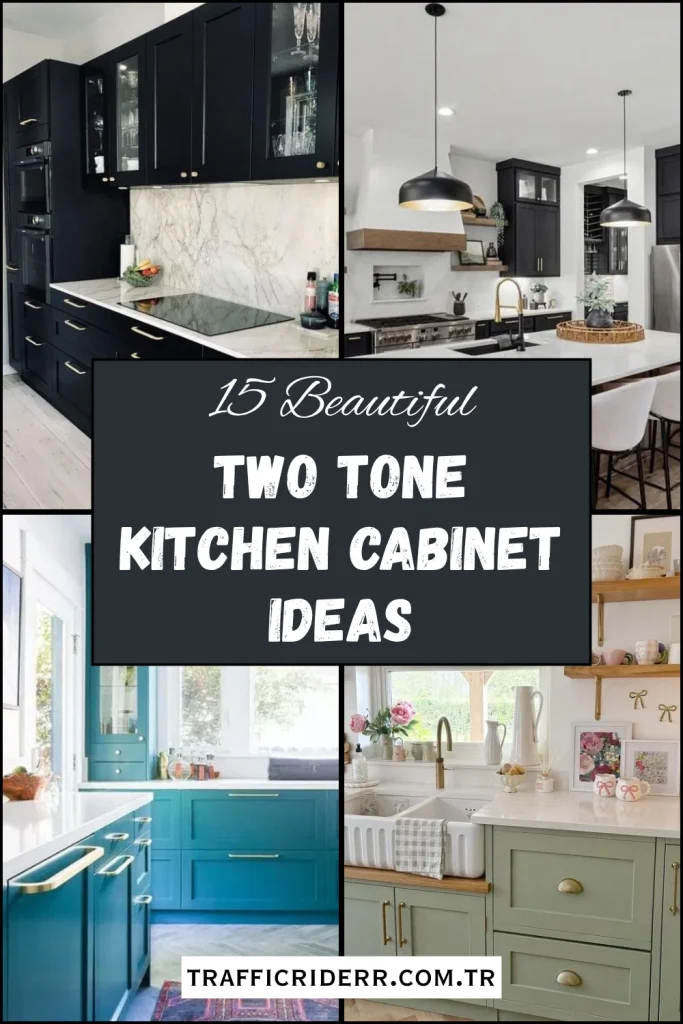
Also read: Grey & White Bedroom Ideas
The Emotional Power of Color in the Kitchen
Color affects how you feel — especially in spaces where you spend time with loved ones. Blues calm, greens refresh, and wood tones warm the soul. Combining two tones allows your kitchen to express your personality while staying cohesive. It’s a creative, budget-friendly way to redesign your space without a full remodel. With the right pairing, your cabinets can transform the entire mood of your home.

Table: Ideal Two-Tone Pairings for Different Kitchen Styles
| Kitchen Style | Upper Cabinets | Lower Cabinets | Overall Mood |
|---|---|---|---|
| Modern Minimalist | White | Matte Black | Sleek and balanced |
| Farmhouse | Cream | Warm Oak | Cozy and inviting |
| Coastal | Sky Blue | White | Airy and fresh |
| Industrial | Grey | Charcoal | Edgy and urban |
| Classic Chic | Soft Beige | Deep Navy | Elegant and timeless |
1. Classic White and Navy Balance
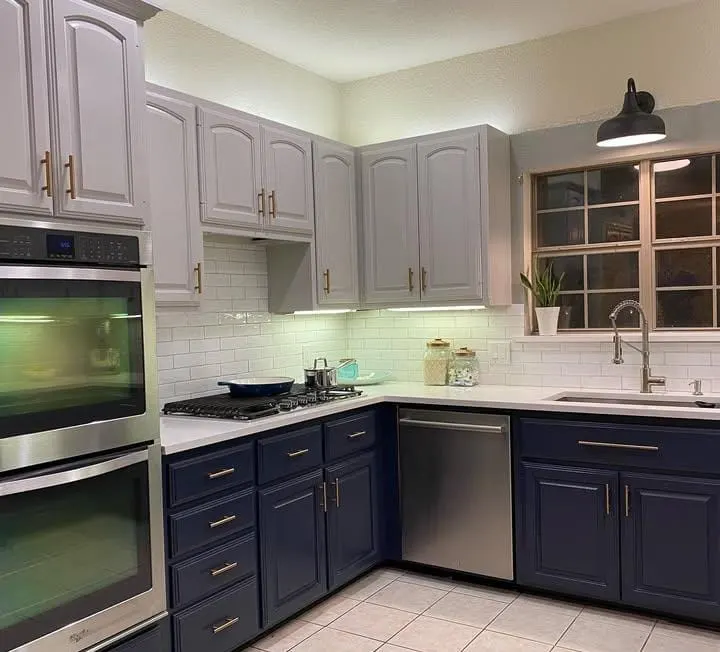
Materials Needed
- Satin white paint
- Deep navy cabinet paint
- Paint rollers, brushes, painter’s tape
- Sandpaper, primer
- Brass handles or gold knobs
Step-by-Step Instructions
- Clean and sand your cabinet surfaces thoroughly.
- Apply a primer coat to both upper and lower cabinets.
- Paint the upper cabinets in satin white using long, smooth strokes.
- Once dry, tape the dividing line carefully.
- Paint the lower cabinets deep navy for contrast.
- Let each coat dry completely before adding a second.
- Replace outdated handles with brass or gold knobs.
- Add under-cabinet lighting for warmth.
- Use white quartz or marble countertops for brightness.
- Finish by sealing the cabinets for durability.
Aesthetic & Functional Benefits
This pairing creates timeless contrast — crisp, bright, and elegant. The navy grounds the space while the white keeps it airy. It’s perfect for both modern and coastal kitchens, offering a classic look that feels both fresh and comforting.
2. Warm Wood and Soft Cream

Materials Needed
- Natural wood stain
- Cream or off-white cabinet paint
- Polyurethane sealant
- Paint brushes, rags, gloves
- Wooden handles or matte black knobs
Step-by-Step Instructions
- Sand down your wooden base cabinets to expose the natural grain.
- Apply wood stain evenly with a clean rag.
- Let it soak for 10–15 minutes, then wipe off the excess.
- Paint the upper cabinets a soft cream tone for brightness.
- Allow both layers to dry overnight.
- Apply a protective polyurethane coat to seal the wood.
- Attach the hardware once completely dry.
- Use light beige or tan countertops to blend smoothly.
- Add pendant lights with warm bulbs.
- Decorate with small plants or ceramic jars for charm.
Aesthetic & Functional Benefits
Wood and cream together create a calming, farmhouse vibe. The natural texture adds warmth, while the cream balances the richness. It’s cozy, timeless, and makes even small kitchens feel welcoming and organic.
3. Charcoal and White Contrast

Materials Needed
- Charcoal grey paint
- Bright white paint
- Painter’s tape, rollers, and primer
- Chrome handles or steel pulls
Step-by-Step Instructions
- Remove cabinet doors and clean thoroughly.
- Apply primer to all surfaces.
- Paint upper cabinets white to reflect light.
- Paint lower cabinets in matte charcoal for sophistication.
- Ensure crisp edges using painter’s tape.
- Install sleek chrome hardware for shine.
- Add under-cabinet LED strips for illumination.
- Incorporate a light backsplash — subway tile works perfectly.
- Reattach doors once paint is cured.
- Finish with stainless steel appliances for uniformity.
Aesthetic & Functional Benefits
The black-and-white dynamic feels bold yet balanced. Charcoal offers grounding depth while white keeps the kitchen spacious. The contrast suits urban apartments and modern homes equally well.
4. Sage Green and White Serenity

Materials Needed
- Sage green cabinet paint
- White satin paint
- Brushes, rollers, painter’s tape
- Wooden knobs or brushed gold handles
Step-by-Step Instructions
- Prep all cabinet surfaces and prime evenly.
- Paint the upper cabinets pure white.
- Paint the lower ones sage green for a touch of nature.
- Let each layer dry overnight.
- Install gold hardware for a refined look.
- Use a natural wood or marble countertop.
- Incorporate rattan bar stools for softness.
- Keep décor minimal — glass jars, white ceramics.
- Add an open wooden shelf above the sink for plants.
- Finish with a warm pendant light for a natural glow.
Aesthetic & Functional Benefits
This duo creates a calming, earthy energy. Sage green is known to reduce stress, while white keeps the area bright. The result feels natural, clean, and welcoming — ideal for kitchens that open into living spaces.
5. Black and Oak Fusion
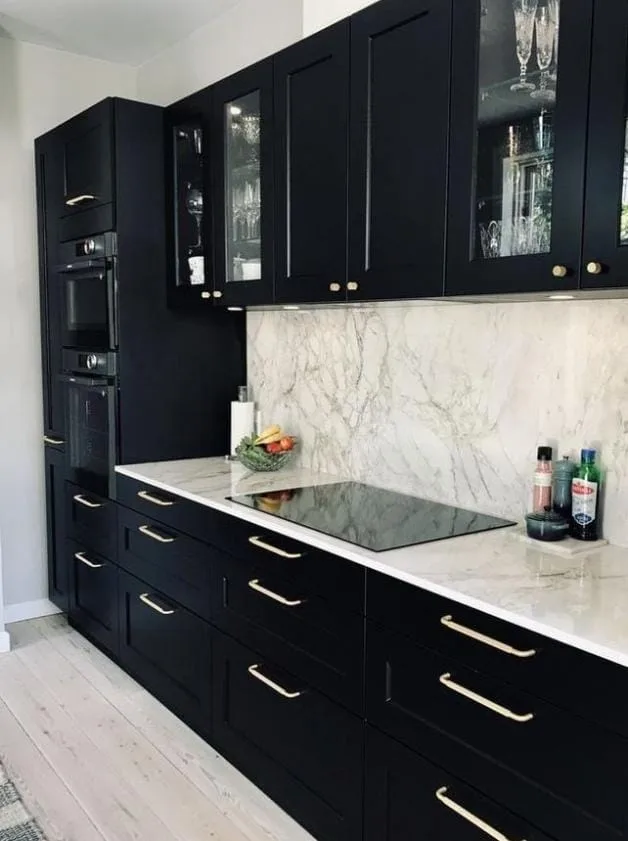
Materials Needed
- Matte black cabinet paint
- Oak veneer panels
- Adhesive, primer, sandpaper
- Satin clear coat, brass handles
Step-by-Step Instructions
- Clean and sand cabinets thoroughly.
- Apply oak veneer panels to lower cabinet doors.
- Paint the upper cabinets matte black.
- Seal the oak surface with a clear coat.
- Use painter’s tape to ensure sharp transitions.
- Add brass or gold handles for warmth.
- Install lighting beneath the uppers to highlight wood grain.
- Pair with a white backsplash for contrast.
- Use open shelves in oak to extend the theme.
- Add matte black appliances to match.
Aesthetic & Functional Benefits
Black and oak create a luxurious, organic balance. The matte texture gives modern appeal, while oak keeps it warm. It’s sophisticated, gender-neutral, and ideal for minimalist yet cozy interiors.
6. Blue and Gray Blend

Materials Needed
- Slate blue paint
- Soft gray paint
- Primer, rollers, painter’s tape
- Nickel handles
Step-by-Step Instructions
- Prime your cabinets evenly.
- Paint upper cabinets gray for a neutral tone.
- Apply slate blue to lower cabinets for color depth.
- Wait between coats for smooth results.
- Add nickel or brushed silver handles.
- Pair with white marble or quartz countertops.
- Include gray-veined backsplash for unity.
- Use warm lighting to balance the cool tones.
- Add soft textiles — linen or jute rugs.
- Keep wall décor minimal.
Aesthetic & Functional Benefits
Blue and gray evoke calm confidence. The pairing feels sophisticated and oceanic — perfect for coastal or transitional kitchens. It offers a serene balance between cool modernity and soft warmth.
7. Forest Green and Brass
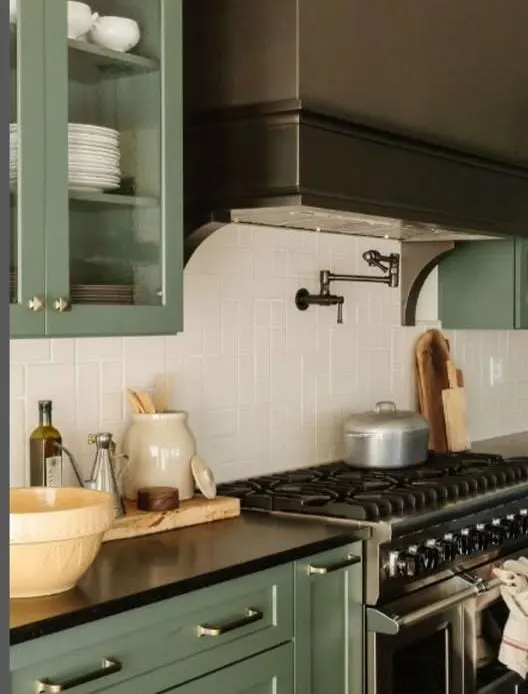
Materials Needed
- Deep forest green paint
- Primer, brushes, sandpaper
- Brass handles, sealant
Step-by-Step Instructions
- Sand and prime cabinets properly.
- Paint base cabinets in forest green using a fine brush.
- Keep uppers white or very light beige.
- Allow full drying before adding hardware.
- Install brass handles for a classic look.
- Add matching brass faucet and lighting fixtures.
- Pair with butcher block countertops.
- Include potted herbs for natural texture.
- Keep window treatments simple.
- Add a framed art print for character.
Aesthetic & Functional Benefits
This palette brings nature indoors. The forest green feels rich and grounding, while brass adds elegance. The mix works for traditional or transitional homes, creating timeless warmth and depth.
8. Light Gray and Walnut Mix
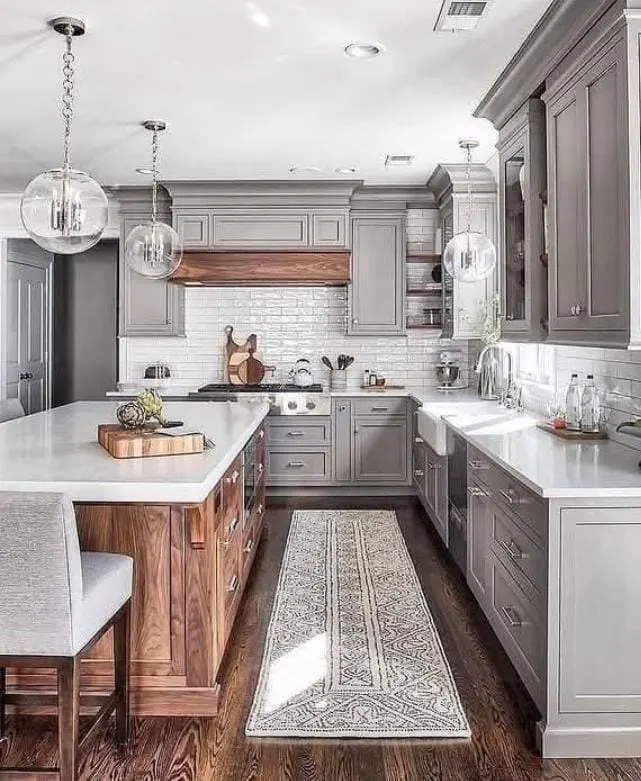
Materials Needed
- Walnut stain
- Light gray paint
- Sandpaper, primer, rags
- Polyurethane sealant
Step-by-Step Instructions
- Sand your base cabinets and apply walnut stain.
- Paint upper cabinets in light gray for balance.
- Use painter’s tape for clean lines.
- Apply a sealant coat to the wood surface.
- Install matte black or steel hardware.
- Pair with a neutral stone backsplash.
- Use under-cabinet lighting to enhance contrast.
- Add floating shelves in walnut for unity.
- Choose light counters to avoid heaviness.
- Finish with subtle décor — ceramic bowls, glass jars.
Aesthetic & Functional Benefits
Gray and walnut feel refined and cozy. The natural wood grain paired with neutral gray adds visual richness while staying calm. This look fits contemporary or Scandinavian kitchens perfectly.
Idea 9: Olive Green and Warm Oak Harmony
Materials/Tools Needed:
Olive green paint (matte finish), sandpaper, primer, natural oak veneer or panels, sealant, paintbrushes, painter’s tape, level, wood polish, microfiber cloth, handles in brushed brass.
Instructions (12–15 lines):
Start by removing all cabinet doors and drawers. Sand them lightly to remove any previous gloss or stain. Apply a primer to the upper cabinets and paint them in a rich olive green hue for a soothing yet sophisticated appeal. For the lower cabinets, attach oak panels or veneer and coat them with a clear sealant to retain their natural warmth. Ensure clean tape lines between the color and wood tones to maintain that crisp two-tone distinction. Reinstall the hardware, opting for brushed brass or muted gold handles for a refined look. Clean all surfaces with a microfiber cloth and polish the oak sections to bring out their natural texture. Finally, style your kitchen with a few potted herbs or a ceramic vase for a refreshing organic touch.
Aesthetic and Functional Benefits (6 lines):
This combination evokes a calm, nature-inspired atmosphere while maintaining visual richness. The olive green adds a grounded, modern tone, while oak brings warmth and texture. It’s ideal for kitchens that need to feel both lively and serene. Functionally, oak’s durability pairs well with easy-to-clean painted surfaces. The look feels balanced, inviting, and timeless — perfect for farmhouse-meets-modern kitchens.
Idea 10: Coastal Blue and White Serenity
Materials/Tools Needed:
Navy or coastal blue paint, bright white semi-gloss paint, primer, foam rollers, painter’s tape, gold or silver hardware, sandpaper, sealant, drop cloths.
Instructions:
Remove all cabinet hardware and clean surfaces thoroughly. Sand lightly and apply primer. Paint upper cabinets in crisp white to reflect light and enhance space, and coat the lower cabinets in a deep coastal blue for contrast. Let the paint dry between coats to achieve a smooth finish. Replace old handles with gold or silver ones to add a touch of luxury. Use a sealant for durability. For a finishing touch, style the space with white ceramics, woven baskets, and coastal artwork to echo beachside vibes.
Aesthetic and Functional Benefits:
This pairing brings an airy, beach-inspired look that instantly brightens the kitchen. White enhances natural light, while blue anchors the space and introduces depth. It’s perfect for those who want a peaceful, relaxed cooking environment. Functionally, this design hides scuffs on lower cabinets while keeping the overall space feeling fresh and open.
Idea 11: Black and Teak Modern Luxe
Materials/Tools Needed:
Matte black paint, teak veneer sheets, primer, adhesive, sanding block, paint roller, polyurethane sealant, modern black handles.
Instructions:
Prepare the cabinets by removing hardware and sanding surfaces. Apply primer to the upper cabinets and paint them matte black for a sleek, bold look. For the lower cabinets, attach teak veneer panels with adhesive and smooth them out to eliminate air bubbles. Seal the veneer with polyurethane to protect against moisture and stains. Install matching black or dark bronze handles to create continuity. Ensure lighting above the cabinets to highlight the teak’s grain and warm undertones.
Aesthetic and Functional Benefits:
This combination defines contemporary elegance. The black provides a strong architectural frame, while teak adds richness and warmth. The balance of dark and natural tones creates a grounded, high-end atmosphere. Functionally, matte finishes hide fingerprints, and teak’s durability withstands heavy use — ideal for active households with a modern aesthetic.
Idea 12: Sage Green and White Oak Simplicity
Materials/Tools Needed:
Sage green paint, white oak veneer, primer, brushes, sealant, microfiber cloth, painter’s tape, light brass or wood handles.
Instructions:
Start with clean, dry cabinets. Apply primer and then coat the upper cabinets in a calming sage green. Sand and refinish the lower cabinets with white oak veneer or stain them to a soft blond tone. Apply sealant for protection. Add natural-toned hardware to tie the palette together. Complement the cabinetry with open wooden shelving, white quartz countertops, and neutral decor accents.
Aesthetic and Functional Benefits:
This palette embodies natural serenity and Scandinavian simplicity. The sage green introduces calm, while white oak adds organic warmth. It works beautifully in airy kitchens with ample sunlight. Functionally, it creates a bright, inviting feel that’s easy to maintain and visually restful for everyday living.
Idea 13: Navy and Walnut Depth
Materials/Tools Needed:
Deep navy blue paint, walnut veneer or stain, primer, painter’s tape, fine brush, sealer, satin-finish brass hardware, microfiber cloth.
Instructions:
Remove doors and sand surfaces. Apply primer and paint the upper cabinets navy blue. Treat lower cabinets with a rich walnut stain for contrast. Let the stain cure completely before sealing it with a clear coat. Attach brass hardware for a sophisticated accent. Keep the walls light or neutral to balance the richness of the cabinetry. Polish for a sleek, professional finish.
Aesthetic and Functional Benefits:
This design exudes timeless refinement and depth. The navy brings cool modernity, while walnut infuses warmth and tradition. Together, they make the kitchen feel both stately and comfortable. Functionally, the darker tones hide smudges and add a sense of luxury without overwhelming the space.
Idea 14: White and Mint Freshness
Materials/Tools Needed:
Mint green paint, bright white paint, primer, fine sandpaper, small brushes, silver or gold knobs, drop cloth, clear protective coat.
Instructions:
Prime all surfaces and paint the upper cabinets white to enhance brightness. Paint the lower cabinets in a soft mint green for a refreshing look. Use painter’s tape for clean division lines. Once dry, seal the paint to protect against moisture. Replace old hardware with modern metallic handles to elevate the overall look. Keep the countertops light-colored for cohesion.
Aesthetic and Functional Benefits:
This cheerful combination introduces freshness and light into the kitchen. The mint adds a playful charm while the white ensures brightness. It’s perfect for smaller kitchens needing visual space expansion. Functionally, this pairing feels hygienic, uplifting, and easy to coordinate with various decor styles.
Idea 15: Charcoal and Cream Modern Elegance
Materials/Tools Needed:
Charcoal gray paint, soft cream paint, primer, rollers, brushes, painter’s tape, stainless steel or black hardware, protective coating.
Instructions:
Clean and prime cabinets thoroughly. Paint the upper cabinets in a creamy tone to soften the look and the lower cabinets in a deep charcoal gray for grounding contrast. Ensure sharp color transitions with painter’s tape. Replace handles with sleek stainless steel or matte black ones. Finish with a protective clear coat for durability. Accent the design with modern pendant lights or a marble backsplash for extra elegance.
Aesthetic and Functional Benefits:
This combination delivers an upscale, hotel-inspired kitchen atmosphere. The cream keeps the room bright, while charcoal adds sophistication and contrast. It’s perfect for homeowners seeking a timeless modern edge. Functionally, darker lower cabinets hide wear and tear while maintaining a luxurious visual balance.
Conclusion
Two-tone kitchen cabinets are more than just a color trend — they’re a visual story that defines your kitchen’s personality. Whether you lean toward bold contrasts or gentle harmonies, every color pairing transforms the space into something truly personal and stylish.
The beauty lies in balance — light meets dark, texture meets tone, and function meets design. Save this guide for your next remodel or share it to inspire someone else’s kitchen transformation. To explore even more home décor inspirations and trending makeovers, continue browsing our latest design collections and Pinterest-worthy ideas on AuraNest — where creativity meets everyday living.


